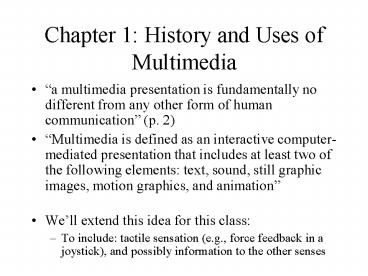Chapter 1: History and Uses of Multimedia - PowerPoint PPT Presentation
1 / 12
Title:
Chapter 1: History and Uses of Multimedia
Description:
'Multimedia is defined as an interactive computer-mediated ... Symbolism. Using an item to represent something else. E.g., film, music. Historical Notes ... – PowerPoint PPT presentation
Number of Views:2834
Avg rating:5.0/5.0
Title: Chapter 1: History and Uses of Multimedia
1
Chapter 1 History and Uses of Multimedia
- a multimedia presentation is fundamentally no
different from any other form of human
communication (p. 2) - Multimedia is defined as an interactive
computer-mediated presentation that includes at
least two of the following elements text, sound,
still graphic images, motion graphics, and
animation - Well extend this idea for this class
- To include tactile sensation (e.g., force
feedback in a joystick), and possibly information
to the other senses
2
Multimedia
- Presentation controlled by a computer
- standard components
- Some necessary technologies
- Capture, Digitization, Storage
- Mixing, Synchronization
- Reproduction, Transmission
- Display of text, graphic, sound, and other data
- Viewers
- Presentation also involves attention to effective
communication
3
Human Communication - 1
- Have you have tried to communicate in real-time
with just text words alone? - Alternatively, what about talking to someone just
over the phone? - Do you find that something is missing?
- What is missing?
- What are the elements or aspects involved in
human communication?
4
Human Communication - 2
- Some elements of human communication
- Intonation
- Meaning
- Emotion
- Knowledge
- Feeling
- Body language
- Gesture
5
Human Communication - 3
- Language
- Sound, gesture, writing
- Storytelling, Theatre, Teaching, Opera
- Movement gesture while telling a story
- Audience interaction (e.g., participation
theatre) - Effective communication
- Attention to your audience (the others) ,
rather than to the communicator (the self) - What does this mean?
- Attention to the content of your presentation
- actor using the audience to achieve the
purpose of the presentation (p. 6)
6
Presentations as
- Creating in an audience a desired transformation
- A gestalt blending of elements
- Illusion
- Creating an illusion in the mind of the audience
7
Representation
- Humans have facility with understanding
representations - E.g., words are representations our minds form
representations of the external world pictures
are representations of reality - Using some forms of media to stand for something
else - Theories of form and color from art
- Symbolism
- Using an item to represent something else
- E.g., film, music
8
Historical Notes
- IBM 1500 (60s) Multimedia computer-assisted
instruction - DEC (60s, 70s) Link trainer virtual reality
flight simulation - 1991 World wide web
- 1992 first childrens interactive book title,
Just Grandma and Me (see p. 9, lab text) - Hardware Has made high real-time data rates
feasible (see p. 14 for rate of change)
sophistication of peripherals cost reductions - Client/server computing
- One computer or process provides a service
(server) - The other computer or process uses this service
(client) - Why?
9
Applications of Multimedia - 1
- Reference material
- Encyclopedias
- Dictionaries
- Entertainment
- Games
- Business
- Computer-assisted instruction (CAI),
computer-based instruction (CBI) - Teaching reading skills
- Underlying assumption?
10
Underlying Assumption
- people learn more when they are actively engaged
in the learning process, interacting with the
instructional materials and exercising some
control employing several different senses and
enjoying entertaining presentations (p. 24)
11
Applications of Multimedia - 2
- Medical scientific analyses, simulations,
presentations - E.g., Interactive scientific visualization
- The Visible Human Project
- Adaptive technology for the disabled
- multimedia is ideally suited for use in
adaptive technologies, because if one medium is
inaccessible to a potential user, another can be
substituted (p. 28) - Virtual reality
- Fine arts humanities
12
Future Developments in Multimedia
- Improvements in artificial intelligence
- E.g., video processing to recognize faces,
gestures - E.g., animated characters (see Justine Cassells
work at www.media.mit.edu) - Computers vanishing into the background
- Wearable computing































